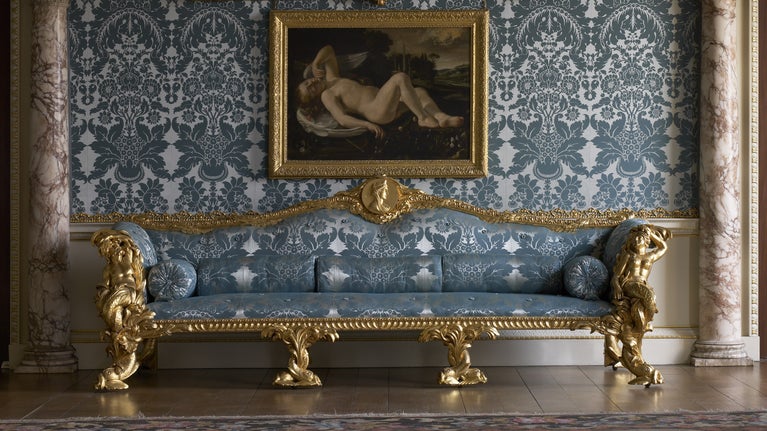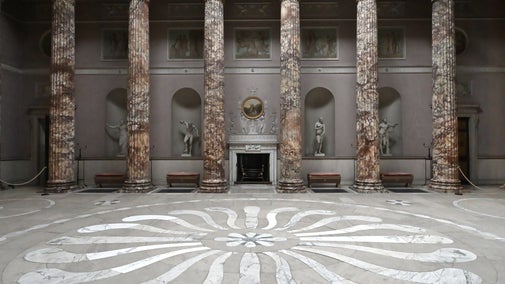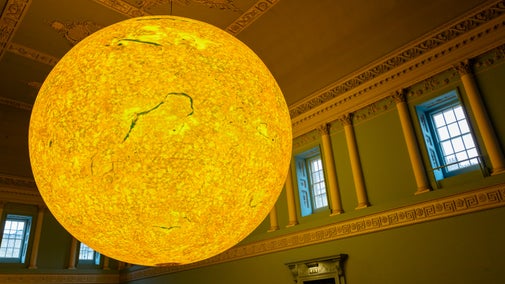
Discover more at Kedleston Hall
Find out when Kedleston Hall is open, how to get here, things to see and do and more.

Kedleston Hall is one of the finest and most complete examples of an 18th-century show-palace and parkland in Britain. Step inside and discover the Curzon family's collection of fine art, furniture, and Asian objects. Here’s what to look out for when you visit the hall.
The Hall is open every day from 11 am - 4pm with last admission at 3.15pm.
Rooms on the State floor (first floor) when open to visitors, are accessible by stairs only.
From the moment you ascend to the State Floor you're transported back to 18th-century opulence. These rooms were designed to showcase the family's wealth and power, and to display their collection of art and furniture. Restored over 30 years, the state floor reflects architect Robert Adam's original vision for Kedleston.
Alongside the family portraits and gilded furniture, make sure to take in the architecture when you're exploring the hall at Kedleston. Even the ceilings are meticulously designed, from the dome of the saloon to the intricately patterned alcove of the dining room.

Kedleston Hall has over 1,000 objects from across the Asian continent. This collection was brought together by George Nathanial Curzon, 1st Marquess Curzon of Kedleston (1859-1925) who inherited the Hall in 1916. Curzon travelled extensively across Asia and in 1899 became the Viceroy of India, making him the highest British representative in colonial India.
Once known as the ‘Indian Museum’ and later the ‘Eastern Museum’, the collection includes objects from countries as diverse as Japan and Turkey, Korea and Nepal. The largest group of objects originate from India, and reflect the period when Curzon was Viceroy (1899-1905). The collection ranges from tourist souvenirs to diplomatic gifts, commissioned pieces and personal items.
The museum at Kedleston was established in 1927 in collaboration with the Victoria and Albert Museum in London. The mode of display and the labelling reflect the period in which it was created.
Research is now underway to conserve and inform a re-presentation of the objects. There are many things we do not know about this collection, numerous questions to be answered and stories to unravel. How and where Curzon acquired the objects is one important question. So too, is their cultural, religious, and artistic significance.
Over the coming months, different partners will help us re-present objects selected from the museum. By shining a light on small groups of objects we hope to explore different stories, spark conversations, and uncover new connections.

The main entrance to the Hall is through a tall gateway and down a slightly sloping path. Visitors who require step free access can get to the hall by using a signposted gate at the rear side of the restaurant. The step free route into the hall will take you through Trophy Corridor and past the entrance to the shop.
Manual wheelchairs are available for use on the first floor.

Find out when Kedleston Hall is open, how to get here, things to see and do and more.
Discover more about Kedleston’s vibrant story and how it’s entangled with global histories, from Rome to India.

Find out how the team at Kedleston Hall have been working to protect and conserve Kedleston Hall’s objects and collections, from books to the 18th-century floor.

Lady Mary Curzon captivated the room in a custom-made peacock dress at the Delhi Durbar ball in 1903. Learn about our work caring for the dress to ensure it continues to demand the limelight.

The grounds at Kedleston are home to a landscaped garden and pleasure grounds designed by Robert Adam. Explore the parkland and discover seasonal wildlife and wildflowers.

Helios is a sun sculpture by Luke Jerram. It's touring some of the places in our care to mark the launch of our new 10-year strategy. Find out where you can visit Helios near you.

Historic houses and buildings are full of stories, art and collections. Learn more about their past and plan your next visit.

Discover the array of houses and buildings to visit around the Peak District and Derbyshire, from historic mills to ornate Elizabethan wonders.
